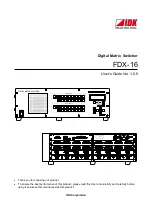
1-2
Figure 1-1
Typical application of MPLS L3VPNs
VPN A
Site 1
VPN A
Site 3
VPN A
Site 5
VPN B
Site 2
VPN B
Site 4
VPN B
Site 6
Core
layer
Edge
layer
CPE
layer
P 1
P 2
P 3
PE 1
PE 2
PE 3
CE 1
CE 2
CE 3
CE 4
CE 5
CE 6
As shown in
Figure 1-1
, VPN A comprises Site 1, Site 3 and Site 5, while VPN B comprises Site 2, Site
4 and Site 6. A VPN involves the following three types of devices:
z
Provider (P) device: device in the core of the provider backbone network. A P device does not
directly interface with CE devices, but it implements MPLS forwarding.
z
Provider edge (PE) device: edge device in the provider backbone network. Directly interfacing with
one or more CE devices, a PE device processes VPN routing as a main MPLS L3VPN
implementer.
z
Customer edge (CE) device: edge device on a customer network. A CE device can be a router, a
switch, or a host, that implements route distribution on the customer network.
In an MPLS L3VPN environment, between any two sites that belong to the same VPN, packets are
transmitted labeled across the public network. The PE device at the entrance to the provider backbone
attaches two labels to the packets, one inner label and the other outer label:
z
Outer label: the label used for switching within the backbone, representing a label switched path
(LSP) from the local PE to the peer PE. With this label, a packet can arrive to the peer PE along the
LSP.
z
Inner label: The inner label represents an LSP between two CE devices interconnected over the
backbone network. It identifies the site to which the packet belongs. The PE forwards the packet to
the target CE based on the inner label.
Introduction to Multicast VPN
As shown in
Figure 1-2
, a network carries three independent multicast services – the public instance,
VPN instance A, and VPN instance B. A PE multicast device at the edge of the public network supports
multiple instances, equivalent to multiple independent multicast devices. Each instance corresponds to
a plane, and all these planes are isolated from one another. For example,
Figure 1-2
shows three
Содержание S7906E - Switch
Страница 82: ...1 4 DeviceA interface tunnel 1 DeviceA Tunnel1 service loopback group 1...
Страница 200: ...1 11 DeviceB display vlan dynamic No dynamic vlans exist...
Страница 494: ...ii Displaying and Maintaining Tunneling Configuration 1 45 Troubleshooting Tunneling Configuration 1 45...
Страница 598: ...ii...
Страница 1757: ...4 9...
Страница 1770: ...6 4...
Страница 2017: ...2 11 Figure 2 3 SFTP client interface...
Страница 2062: ...i Table of Contents 1 URPF Configuration 1 1 URPF Overview 1 1 What is URPF 1 1 How URPF Works 1 1 Configuring URPF 1 2...
Страница 2238: ...1 16 DeviceA cfd linktrace service instance 1 mep 1001 target mep 4002...
Страница 2442: ...2 4 Set the interval for sending Syslog or trap messages to 20 seconds Device mac address information interval 20...
















































